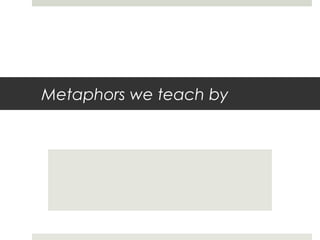
Metaphors Shape Teaching and Learning
- 1. Metaphors we teach by
- 2. Metaphors we live by The title is taken from George Lakoff and Mark Johnson’s (1980) book ‘Metaphors We Live By’ They argue that much of our thinking about everything is in terms of metaphors
- 3. Metaphors link a new and unfamiliar concept to an existing well-known concept They are related to similes and analogies
- 4. Our purpose this morning is to spend a little time thinking about the metaphors that we unconsciously use in thinking about teaching and learning, and make them conscious and explicit for ourselves so that we can evaluate whether or not they are helpful in meeting our goals/living our values
- 5. Your Learning Metaphor Think for a moment about what image or metaphor you use when you think about learning (Start with your own learning) Draw a picture or diagram to try to capture the essence of your metaphor for learning
- 6. Your Teaching Metaphor Now repeat the process but for your metaphor for teaching Don’t represent what you think I want to hear, or an orthodox middle years perspective, represent what you really believe about teaching Draw a picture or diagram to represent your teaching metaphor
- 7. Sharing your metaphors Share your learning and teaching metaphors with the person next to you Make sure you really understand both metaphors of the person next to you - ask questions for clarification
- 8. Coherence and Consistency Make a judgement about whether the learning and teaching metaphors of the person next to you hang together - do the assumptions about learning play out in the assumptions about teaching? Why or why not?
- 9. Classroom Implications Return to looking at your own learning and teaching metaphors What changes would be required to the way we currently ‘do school’ - both at the classroom level and more broadly - in order to allow you to more fully teach in accordance with your metaphors? (specify the level of schooling you’re imagining - maybe a school you went to or that your kids go to)
- 10. Working or Learning? Alfie Kohn has written about how ‘work’ is the wrong metaphor for school – class work, home work and so on – and we should talk about learning Are his arguments plausible? Does this make sense to you? How might this change of metaphors what you do in the classroom?
- 11. Other harmful or unhelpful metaphors Alfie Kohn suggests that the ‘work’ metaphor is unhelpful for schools Can you think of other metaphors that impact on teaching as a profession that are unhelpful?
- 12. Metaphors we teach by The notion of metaphors and of exploring our metaphors (and being aware of the metaphors used by others) is valuable to professional teachers as a tool for exploring some of the hidden assumptions that can help or hinder learning
